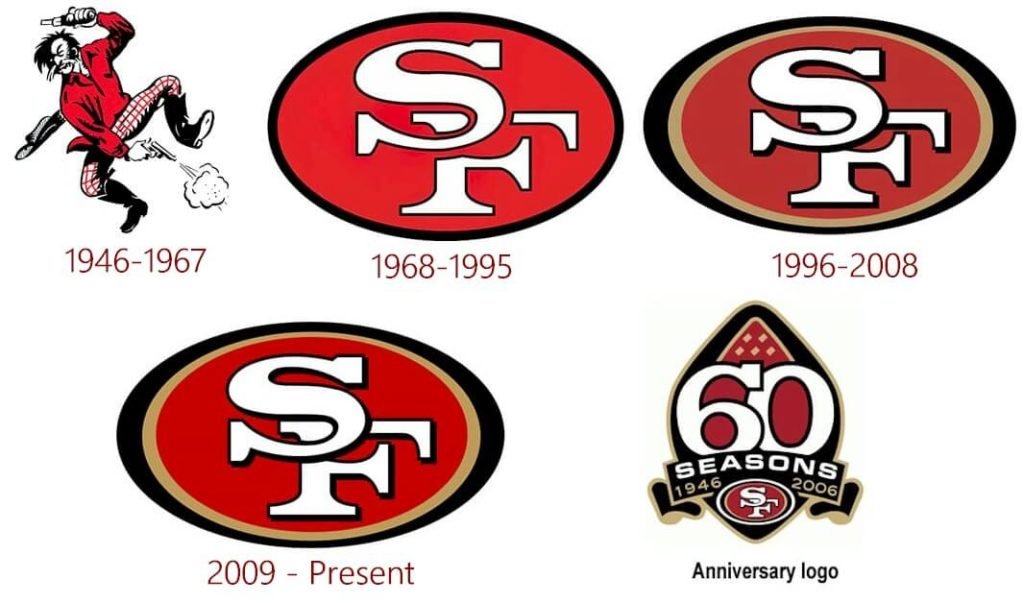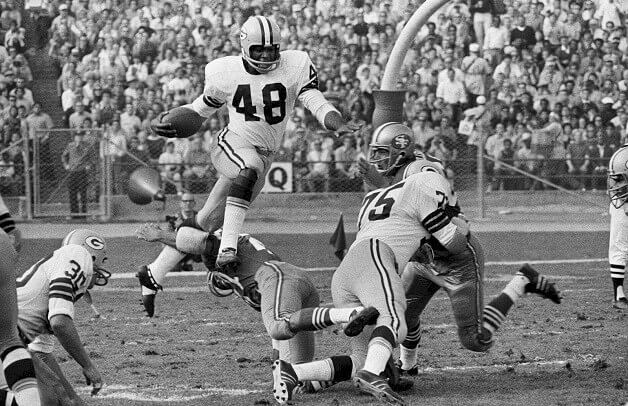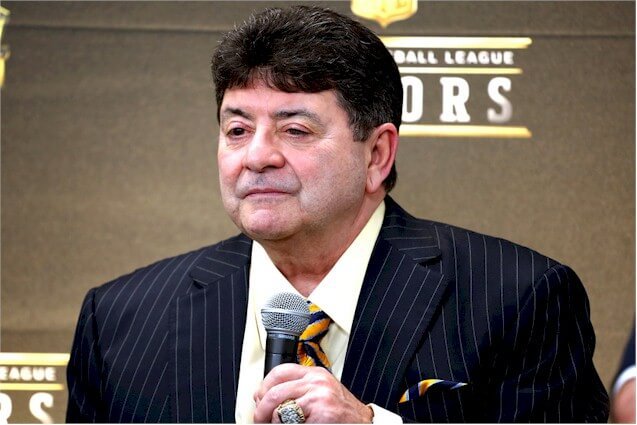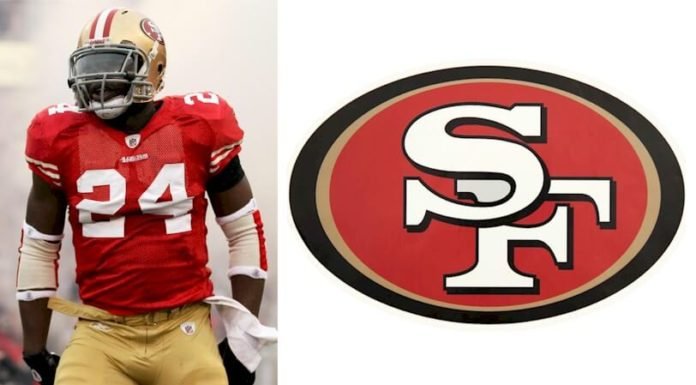This is a look at the 49ers Logo and the History of this sports team.
The current San Francisco 49ers logo features an oval/ellipse, which alludes to the game ball’s shape and the initials “SF” inside it. The “S” is placed on top and interlocks with the “F” below it to form a monogram. The oval, elliptical shape is a bright red, with a thick black outline, followed by an inner gold lining. The letters are both white, also with a visible black outline and a shadow effect.
The San Francisco 49ers are an All American Football team that competes in the National Football League (NFL), with the San Francisco Bay Area as their home base. The club’s name was inspired by the California Gold Rush of 1849, which had attracted droves of gold-seekers to the San Francisco Bay area.
The 49ers represent the West division in the National Football Conference. They play their home matches at Levi’s Stadium in Santa Clara, California, where they’ve been headquartered since 1988. The 49ers were originally a member of the All-America Football Conference (AAFC) when they were founded in 1946, and joined the NFL shortly after the merger of the two leagues in 1949.
The original 49ers logo featured a drawing of a mustached man depicting the 1849 Gold Rush in California. The character is dressed in a reddish shirt, plaid pants, and dark boots, and his hat is falling off as he fires a pistol in mid-air.
The 49ers then updated their symbol to the iconic red oval shape in 1968. The 49ers symbol and logo has undergone several minor alterations over the years, most notably the addition of the outlines to the shape and letters.
49ers Logo Design Elements

49ers Logo Shape: The shape of the 49ers logo is an ellipse inspired by the game’s ball. Compared to earlier versions, the current elliptical representation matches the ball’s actual proportions, having been stretched wider.
49ers Logo Font: The initials “SF” are a monogram created with a custom typeface, a serif that can be said to belong to the antiquity category. The letters are handwritten rather than typed, which helps create a unique, memorable brand identity for the team.
49ers Logo Colors: The monogram is white, with a thick black outline and a dark shadow effect. The oval center is a bright red, and the outlines are a thick gold encapsulated in a thick black outer border.
San Francisco 49ers Logo Evolution
The San Francisco 49ers have had two main symbols for their logo since their inception in 1946: the gold digger character firing a pistol and the oval shape with the monogram.

Their first San Francisco 49ers logo was the conception of Allen Sorrel, who had partnered up with Anthony J. Morabito to acquire the team. He had just recently seen a drunken gold digger standing beside a freight train, holding a pistol in each hand, and decided it would be a great image to communicate the 49ers’ concept.
49ers Logo 1968 – 1995
In 1968, the 49ers switched to a more straightforward logo, more conventional symbol. The new logo was a deep red oval shape with a black outline, with the “SF” monogram in white at the center. The letters were in a custom typeface and have remained the font of choice to this day. The new version was meant to identify the club as a team from San Francisco.
It was a complete departure from the old gold-digger character drawing, and thanks to its longevity, it’s become a widely recognizable symbol in America.
49ers Logo 1996 – 2008
In 1996, the 49ers logo underwent some minor changes. The ellipse was stretched a little to the sides to more closely reflect the American football shape. A gold outline inside the black outer border was added, hinting at the Gold Rush history and its connection with the 49ers.
And unlike the previous uniform black lining, the two borders were made thicker on the sides but thinner towards the center. The inner red of the oval was switched to a darker shade. The “S,” which cut through the “F” and separated it into three parts, now only overlapped it. The monogram also acquired a dark outline that produces a shadow effect.
49ers Logo 2009 – Present
The latest version from the 2009 49ers logo has stayed the same except for the changes to the color pallet. The dark red was replaced by a brighter scarlet red, while the gold lining was made a shade lighter. The monogram also took on a brighter white from the previous dull white.
The History of San Francisco 49ers
Anthony J. Morabito is widely recognized as a pioneer of sports on the West Coast. The 49ers were the first major league sports team when he brought them to San Francisco in 1946. During those times, professional sports were dominated by clubs on the East Coast.
After World War II, Morabito strongly believed that the Bay Area was ready for a pro football team in the NFL. This is because the Bay Area was already a Mecca of sorts for college football. Thousands of fans came to the Kezar Stadium to watch teams such as the Wow Boys of Stanford, the University of San Francisco, and the California-Berkeley team.
Morabito watched the popularity of the game rise in the area and met officials from the NFL to discuss the birth of a new team. That was in 1942. He was, however, politely turned down. He tried again in 1944, this time together with a few business associates. They flew to Chicago to present their case to the NFL Commissioner. At this point, the NFL did not have any team in the West of Chicago and had no desire to alter their geographical outlook, so they knocked back Morabito once again.
Morabito was then put in touch with the sports editor of the Chicago Tribune named Arch Ward, who was working on plans for a rival league, the All-America Football Conference. Impressed by Ward, Morabito was all in.
The new league’s first meeting was on June 6, 1944, in St. Louis. Morabito agreed to form a San Francisco franchise in a league that would not begin operations until the end of the war.
On June 6, 1944, the first meeting to discuss the proposed league was held in St. Louis. This was around the time World War II was heating up, and Morabito agreed to form a San Francisco team for the league, which would kick off after the war.
1946–1949: The Early Years in the AAFC
The 49ers started their professional football adventure in the All-America Football Conference in 1946. They had the distinction of being the very first team from the West Coast in the four major sports leagues.
Tony Morabito had tried without success to enter the NFL, but with the formation of the AAFC, he and his team could now take advantage of air travel and participate in a genuine national sports league. It was the advent of air travel in the early 1940s that had initially convinced Morabito about expanding the NFL’s reach to the West.
The 49ers were unlucky to have been included in the same division as the Cleveland Browns, whose dominance they could not topple. They had been responsible for two of the Browns only four defeats but finished second behind them each time.
They were, however, the second-best team in the entire AAFC in those first years. For this reason, the 49ers, along with the Baltimore Colts and the Cleveland Browns, were admitted into the NFL in 1950.
Moving to the NFL
Following the dissolution of the AAFC and their move into the NFL, the management team remained intact, headed by co-owners Anthony J. Morabito and Victor P. Morabito, and Louis Spadia, the General Manager. However, the team struggled for any major success throughout the 1950s.
49ers In the 1960s

In the 1960s, the 49ers were the first team in the NFL to try out the shotgun formation. The formation was the brainchild of Red Hickey. With this strategy, the quarterback would line up seven yards behind the center, which would buy him extra time to pass through.
With this formation, the 49ers were able to defeat the Baltimore Colts, who were surprised by it. At the end of the decade the 49ers were yet to boast of any significant title success.
49ers In the 1970s

The 49ers flirted with glory for three successive seasons, between 1970 and 1972. They had captured the Western Conference title in each of these seasons, but the Dallas Cowboys eliminated them in the championship and playoff games. In 1971, the club ditched the Kezar Stadium for their new home, the 68,000-seater Candlestick Park.
After struggling for several seasons, a bright new dawn came in March of 1977, when they were acquired by Edward J. DeBartolo Jr. DeBartolo set himself the goal of helping the 49ers to their first-ever league title. He appointed Bill Walsh, an offensive specialist, as the new head coach. It would take Walsh just three seasons to finally bring championship honors, with his 26-21 triumph over Cincinnati in Super Bowl XVI.
More glory was to follow in the subsequent years, with a memorable last-gasp Super Bowl XXIII win: 20 – 16 against Cincinnati. After ten years at the helm, Walsh had managed an impressive six NFC West titles and three Super Bowl Championships.
49ers In the 1980s
In the 1980s, the San Francisco 49ers boasted a team full of young stars, including Joe Montana, Jerry Rice, Dwight Clark, Ronnie Lott, and Roger Craig. George Seirfeit had taken over from Walsh and continued to take advantage of the talent at his disposal.
The 49ers were rewarded for their effective personnel planning, which ensured that talented youngsters were on hand to replace retiring veterans. One fine example is Steve Young, who took over Montana’s quarterback position, who struggled with multiple injury setbacks before leaving the club.
Seifert had an impressive record at the 49ers, with two Super Bowl wins. The first was Super Bowl XXIV, a 55-1 success against Denver Broncos, and the second was Super Bowl XXIX, a 49-26 win over San Diego Chargers.
1999–2010: 49ers Going Downhill

The 49ers experienced a slump during this period, thanks to a few management struggles. Eddie DeBartolo, Jr. was facing corruption allegations in the late 1990s.
One high profile case involved one of Louisiana Governor Edwin Edward’s casinos. In 1998, he pleaded guilty to failure to report a felony charge and was subsequently suspended from running the club for a year. With some help from her husband John York, his sister, Denise DeBartolo York, took over the club’s reigns. John was officially named CEO, while Denise became chairperson of the board.
After his suspension, DeBartolo returned to the helm, but family wrangles involving lawsuits forced him to surrender control of the club to the Yorks as part of the settlement deal.
49ers 2017-Present
2017 marked the beginning of the Kyle Shanahan era. The 49ers kicked off the new era with nine straight losses before managing their first win of against the New York Giants. After bringing on quarterback Jimmy Garoppolo at the end of October 2017, the team experienced an upturn in their fortunes. The 49ers won their first five matches with Garoppolo, a winning streak that led them to finish the season at 6-10.
However, the beginning of the 2018 season was a tough one with the team in shambles after Garoppolo tore his anterior cruciate ligament (ACL) in late September. Many other players battled injuries throughout the season, leading the 49ers to end their season at 4-12.
The Takeaway
The San Francisco 49ers Logo and the team will forever be known as the team that pioneered league football on the West Coast, thanks to one relentless man, Tony Morabito. After a few years of being second best behind the Cleveland Browns in the AAFC, the 49ers began their National League Football adventure in 1950.
For years before 1977, when Edward J. DeBartolo Jr. took over, the club had not bagged a single Super Bowl title. All of this changed with Walsh as their newly appointed coach—he led them to three Championships in 10 years. The 1980s was the golden age for the club who has mostly struggled in the last three decades and is now in the middle of a major rebuilding plan.







